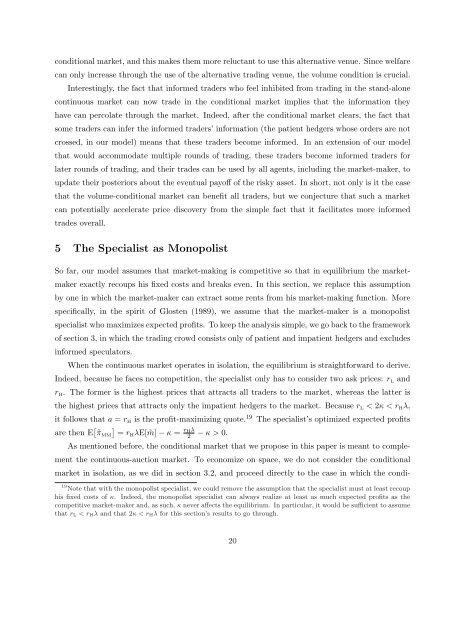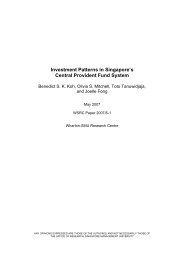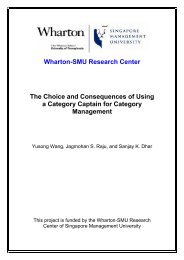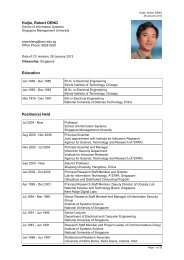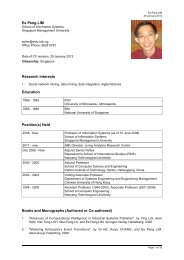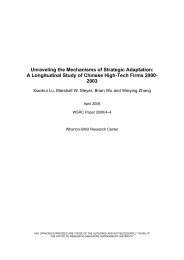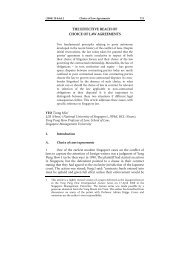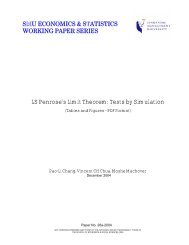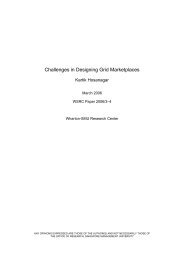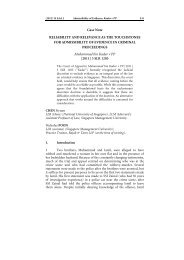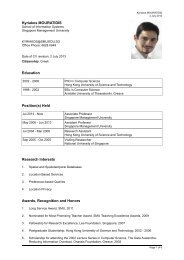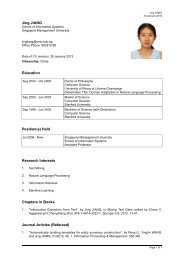The Benefits of Volume-Conditional Order-Crossing - Singapore ...
The Benefits of Volume-Conditional Order-Crossing - Singapore ...
The Benefits of Volume-Conditional Order-Crossing - Singapore ...
Create successful ePaper yourself
Turn your PDF publications into a flip-book with our unique Google optimized e-Paper software.
conditional market, and this makes them more reluctant to use this alternative venue. Since welfare<br />
can only increase through the use <strong>of</strong> the alternative trading venue, the volume condition is crucial.<br />
Interestingly, the fact that informed traders who feel inhibited from trading in the stand-alone<br />
continuous market can now trade in the conditional market implies that the information they<br />
have can percolate through the market. Indeed, after the conditional market clears, the fact that<br />
some traders can infer the informed traders’ information (the patient hedgers whose orders are not<br />
crossed, in our model) means that these traders become informed. In an extension <strong>of</strong> our model<br />
that would accommodate multiple rounds <strong>of</strong> trading, these traders become informed traders for<br />
later rounds <strong>of</strong> trading, and their trades can be used by all agents, including the market-maker, to<br />
update their posteriors about the eventual pay<strong>of</strong>f <strong>of</strong> the risky asset. In short, not only is it the case<br />
that the volume-conditional market can benefit all traders, but we conjecture that such a market<br />
can potentially accelerate price discovery from the simple fact that it facilitates more informed<br />
trades overall.<br />
5 <strong>The</strong> Specialist as Monopolist<br />
So far, our model assumes that market-making is competitive so that in equilibrium the market-<br />
maker exactly recoups his fixed costs and breaks even. In this section, we replace this assumption<br />
by one in which the market-maker can extract some rents from his market-making function. More<br />
specifically, in the spirit <strong>of</strong> Glosten (1989), we assume that the market-maker is a monopolist<br />
specialist who maximizes expected pr<strong>of</strong>its. To keep the analysis simple, we go back to the framework<br />
<strong>of</strong> section 3, in which the trading crowd consists only <strong>of</strong> patient and impatient hedgers and excludes<br />
informed speculators.<br />
When the continuous market operates in isolation, the equilibrium is straightforward to derive.<br />
Indeed, because he faces no competition, the specialist only has to consider two ask prices: r L and<br />
r H. <strong>The</strong> former is the highest prices that attracts all traders to the market, whereas the latter is<br />
the highest prices that attracts only the impatient hedgers to the market. Because r L < 2κ < r Hλ,<br />
it follows that a = rH is the pr<strong>of</strong>it-maximizing quote. 19 <strong>The</strong> specialist’s optimized expected pr<strong>of</strong>its<br />
are then E <br />
˜π MM = rHλE[ ˜m] − κ = rHλ<br />
− κ > 0.<br />
2<br />
As mentioned before, the conditional market that we propose in this paper is meant to comple-<br />
ment the continuous-auction market. To economize on space, we do not consider the conditional<br />
market in isolation, as we did in section 3.2, and proceed directly to the case in which the condi-<br />
19 Note that with the monopolist specialist, we could remove the assumption that the specialist must at least recoup<br />
his fixed costs <strong>of</strong> κ. Indeed, the monopolist specialist can always realize at least as much expected pr<strong>of</strong>its as the<br />
competitive market-maker and, as such, κ never affects the equilibrium. In particular, it would be sufficient to assume<br />
that rL < rHλ and that 2κ < rHλ for this section’s results to go through.<br />
20


